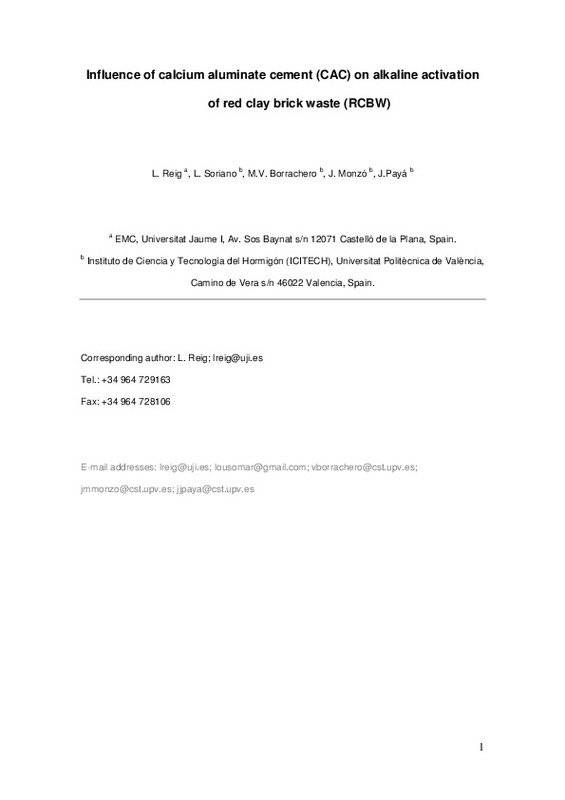JavaScript is disabled for your browser. Some features of this site may not work without it.
Buscar en RiuNet
Listar
Mi cuenta
Estadísticas
Ayuda RiuNet
Admin. UPV
Influence of calcium aluminate cement (CAC) on alkaline activation of red clay brick waste (RCBW)
Mostrar el registro sencillo del ítem
Ficheros en el ítem
| dc.contributor.author | Reig Cerdá, Lucía
|
es_ES |
| dc.contributor.author | Soriano Martínez, Lourdes
|
es_ES |
| dc.contributor.author | Borrachero Rosado, María Victoria
|
es_ES |
| dc.contributor.author | Monzó Balbuena, José Mª
|
es_ES |
| dc.contributor.author | Paya Bernabeu, Jorge Juan
|
es_ES |
| dc.date.accessioned | 2017-05-18T13:47:49Z | |
| dc.date.available | 2017-05-18T13:47:49Z | |
| dc.date.issued | 2016-01 | |
| dc.identifier.issn | 0958-9465 | |
| dc.identifier.uri | http://hdl.handle.net/10251/81418 | |
| dc.description.abstract | In this paper, the effect of calcium aluminate cement (CAC) additions on the alkali activation of red clay brick waste (RCBW) was studied at room temperature and at 65 C. RCBW was partially replaced with CAC (0e50 wt.%) and blends were activated with NaOH and sodium silicate solutions. The compressive strength evolution was tested on mortars and the nature of the reaction products was analysed by infrared spectroscopy, X-ray diffraction, thermogravimetric analysis, microscopic studies and pH measurements. The results show that the use of CAC accelerates the activation process of RCBW so that 50 MPa were obtained in the blended mortars containing 40 wt.% CAC cured for 3 days at room temperature. CAC did not undergo normal hydration and only the C3AH6 phase was identified in the pastes blended with more than 30 wt.% CAC and cured at 65 C, while the main reaction product was a cementitious gel containing Ca and Al from CAC. | es_ES |
| dc.description.sponsorship | The authors are grateful to the Spanish Ministry of Science and Innovation for supporting this study through Project GEOCEDEM BIA 2011-26947, and to FEDER funding. | en_EN |
| dc.language | Inglés | es_ES |
| dc.publisher | Elsevier | es_ES |
| dc.relation.ispartof | Cement and Concrete Composites | es_ES |
| dc.rights | Reserva de todos los derechos | es_ES |
| dc.subject | Ceramic waste | es_ES |
| dc.subject | Waste management | es_ES |
| dc.subject | Alkali-activation | es_ES |
| dc.subject | Calcium aluminate cement | es_ES |
| dc.subject | Compressive strength | es_ES |
| dc.subject | Microstructure | es_ES |
| dc.subject.classification | INGENIERIA DE LA CONSTRUCCION | es_ES |
| dc.title | Influence of calcium aluminate cement (CAC) on alkaline activation of red clay brick waste (RCBW) | es_ES |
| dc.type | Artículo | es_ES |
| dc.identifier.doi | 10.1016/j.cemconcomp.2015.10.021 | |
| dc.relation.projectID | info:eu-repo/grantAgreement/MICINN//BIA2011-26947/ES/REUTILIZACION DE RESIDUOS CERAMICOS Y DE DEMOLICION EN LA PREPARACION DE NUEVOS MATERIALES GEOPOLIMERICOS/ | es_ES |
| dc.rights.accessRights | Abierto | es_ES |
| dc.contributor.affiliation | Universitat Politècnica de València. Escuela Técnica Superior de Ingenieros de Caminos, Canales y Puertos - Escola Tècnica Superior d'Enginyers de Camins, Canals i Ports | es_ES |
| dc.contributor.affiliation | Universitat Politècnica de València. Instituto de Ciencia y Tecnología del Hormigón - Institut de Ciència i Tecnologia del Formigó | es_ES |
| dc.description.bibliographicCitation | Reig Cerdá, L.; Soriano Martínez, L.; Borrachero Rosado, MV.; Monzó Balbuena, JM.; Paya Bernabeu, JJ. (2016). Influence of calcium aluminate cement (CAC) on alkaline activation of red clay brick waste (RCBW). Cement and Concrete Composites. 65:177-185. https://doi.org/10.1016/j.cemconcomp.2015.10.021 | es_ES |
| dc.description.accrualMethod | S | es_ES |
| dc.relation.publisherversion | https://doi.org/10.1016/j.cemconcomp.2015.10.021 | es_ES |
| dc.description.upvformatpinicio | 177 | es_ES |
| dc.description.upvformatpfin | 185 | es_ES |
| dc.type.version | info:eu-repo/semantics/publishedVersion | es_ES |
| dc.description.volume | 65 | es_ES |
| dc.relation.senia | 324582 | es_ES |
| dc.contributor.funder | Ministerio de Ciencia e Innovación | es_ES |






![[Cerrado]](/themes/UPV/images/candado.png)


